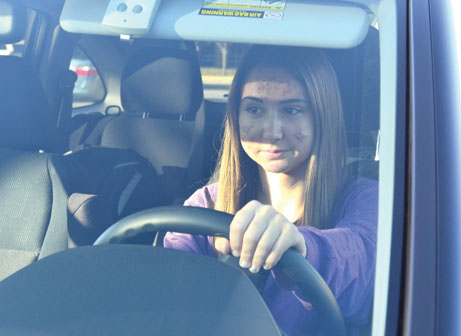Junior Sydne Horton was in high spirits as she drove home with her friends one day after school, laughing and talking about their plans for the day with music blasting from the speakers. Up ahead, a stoplight turned yellow, and in a move that surprises her now, Horton hit the gas.
“I decided, I guess, that I should speed up, so I went 10 miles (per hour) over the speed limit, straight for the stoplight, and turned left,” Horton said. “I lost control of my car and hit the curb, which bounced us into incoming traffic.”
Fortunately, Horton said, approaching cars were able to stop, and she, her friends and her car all escaped unscathed. Now, she said, she is still unsure why she didn’t slow down as she normally does when approaching a yellow light. However, she said she is quite certain it wouldn’t have happened if she had been driving alone.
Horton’s sudden impulse to rush through a yellow light reflects a trend uncovered last year in a study by researchers at Temple University.

The study found that adolescents are more likely than any other age group to engage in risky behavior when observed by their friends. In the study, when teenage participants played a simulated driving-game in the presence of peers, they took more risks, like running through yellow lights, than when they played alone.
According to Judith Bealke, assistant professor of clinical psychiatry at the IU School of Medicine, this behavior stems from the physical, mental and social changes that accompany adolescence, including brain development in areas that control impulsive behavior.
“(Teenagers are) under major construction. Impulsivity is just part of the package, by virtue of the neurophysiology,” Bealke said.
Horton said she has seen such risky behavior increase as she and her peers have entered adolescence and started driving.
“When I was little, I didn’t do as much crazy stuff as I do now,” Horton said. “I definitely think (risky behavior) is a teenager thing.”
Another factor that could affect why teenagers are inclined to take risks around friends is the increasing importance of social acceptance, Bealke said.
According to Horton, while her friends don’t actively try to influence her behavior, she has noticed herself becoming more self-conscious as an adolescent.
“You just want to impress other people (and) stay friends with them,” Horton said.
However, this mentality is not universal for all students. According to junior Sam Patterson, he tries not to let the opinions of others influence him, so having friends accompany him as he drives does not encourage him to take risks. Still, he said, he would consider social approval a motivating factor in teenage impulsivity.
“Why would you act ‘riskily’ (among friends) unless it mattered to you what they thought?” Patterson said. “More importantly, why does acting ‘riskily’ matter to them? It baffles me, personally. I can’t think why.”
Despite the negative connotations attached to teenage risk-taking, Bealke said, teenagers can also influence their friends to take positive risks by introducing them to new experiences.
“Peers can push their friends into different directions that they never would have thought about before,” Bealke said.
In the end, Bealke said, adults should not try to teach teenagers to refuse all risks but rather help them find an identity without damaging their well-being.
“The most important thing is not to try to teach a (teenager) just to say ‘no’ because that doesn’t work, but to help a kid stay in touch with their internal values,” she said.
Having the mind-set to make safe decisions when entering a potentially risky situation, even such as driving with friends, Bealke said, would help prevent teenagers from impulsively putting themselves and their passengers in danger.
For Patterson, he said the value of keeping his friends safe when he drives with them supersedes any temptation to impress them through risky driving behavior.
“When I’m driving with other people, I’m more responsible for their safety, obviously, so I try to drive more safely. At least consciously, I do,” Patterson said.
For Horton, she said her decision to speed through a yellow light wasn’t conscious. According to her, she’s still not quite sure how it happened. She attributes a large part of her split-second decision to distraction, she said, heightening her excitement and slackening her caution.
“I wasn’t even thinking,” she said. “I think definitely, having friends in the car changes everything.”

































![AI in films like "The Brutalist" is convenient, but shouldn’t take priority [opinion]](https://hilite.org/wp-content/uploads/2025/02/catherine-cover-1200x471.jpg)









































![Review: “The Immortal Soul Salvage Yard:” A criminally underrated poetry collection [MUSE]](https://hilite.org/wp-content/uploads/2025/03/71cju6TvqmL._AC_UF10001000_QL80_.jpg)
![Review: "Dog Man" is Unapologetically Chaotic [MUSE]](https://hilite.org/wp-content/uploads/2025/03/dogman-1200x700.jpg)
![Review: "Ne Zha 2": The WeChat family reunion I didn’t know I needed [MUSE]](https://hilite.org/wp-content/uploads/2025/03/unnamed-4.png)
![Review in Print: Maripaz Villar brings a delightfully unique style to the world of WEBTOON [MUSE]](https://hilite.org/wp-content/uploads/2023/12/maripazcover-1200x960.jpg)
![Review: “The Sword of Kaigen” is a masterpiece [MUSE]](https://hilite.org/wp-content/uploads/2023/11/Screenshot-2023-11-26-201051.png)
![Review: Gateron Oil Kings, great linear switches, okay price [MUSE]](https://hilite.org/wp-content/uploads/2023/11/Screenshot-2023-11-26-200553.png)
![Review: “A Haunting in Venice” is a significant improvement from other Agatha Christie adaptations [MUSE]](https://hilite.org/wp-content/uploads/2023/11/e7ee2938a6d422669771bce6d8088521.jpg)
![Review: A Thanksgiving story from elementary school, still just as interesting [MUSE]](https://hilite.org/wp-content/uploads/2023/11/Screenshot-2023-11-26-195514-987x1200.png)
![Review: "When I Fly Towards You", cute, uplifting youth drama [MUSE]](https://hilite.org/wp-content/uploads/2023/09/When-I-Fly-Towards-You-Chinese-drama.png)
![Postcards from Muse: Hawaii Travel Diary [MUSE]](https://hilite.org/wp-content/uploads/2023/09/My-project-1-1200x1200.jpg)
![Review: "Ladybug & Cat Noir: The Movie," departure from original show [MUSE]](https://hilite.org/wp-content/uploads/2023/09/Ladybug__Cat_Noir_-_The_Movie_poster.jpg)
![Review in Print: "Hidden Love" is the cute, uplifting drama everyone needs [MUSE]](https://hilite.org/wp-content/uploads/2023/09/hiddenlovecover-e1693597208225-1030x1200.png)
![Review in Print: "Heartstopper" is the heartwarming queer romance we all need [MUSE]](https://hilite.org/wp-content/uploads/2023/08/museheartstoppercover-1200x654.png)




